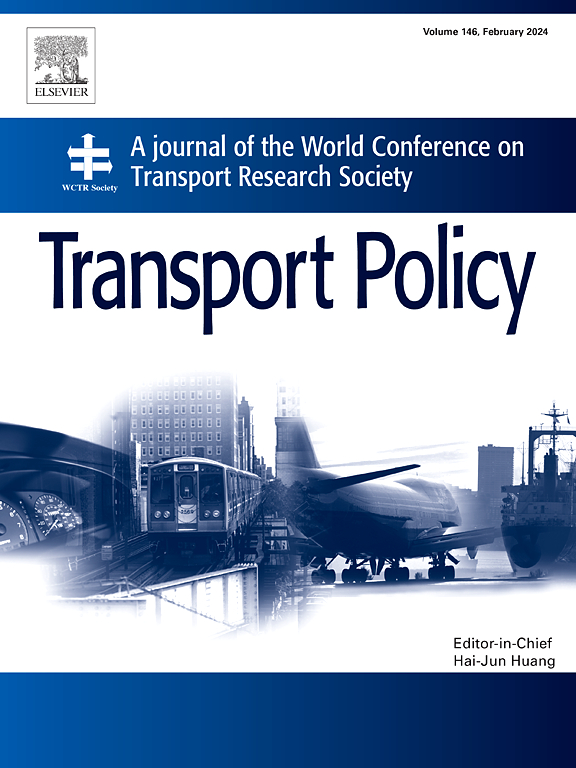微观交通动力学背景下的无线充电设施选址决策
IF 6.3
2区 工程技术
Q1 ECONOMICS
引用次数: 0
摘要
电池电动汽车(BEV)是传统内燃机汽车(ICEV)的可行替代品之一,其推广旨在减少道路交通的温室气体排放。然而,充电时间长和充电设施不足导致了 "续航焦虑",阻碍了 BEV 的发展。无线充电(WC)技术已开始应用于 BEV,帮助实现车辆在道路上行驶时的动态充电。无线充电设施的充分部署可使 BEV 旅行者无需停车充电即可完成旅行。因此,在技术成熟和设施安装之前,WC 设施位置决策是一个必须解决的优化问题。由于速度和加速度等车辆动态取决于交通状态,因此能源消耗也是动态的。根据恒定的速度和能耗部署 WC 设施可能无法满足充电需求,电池中储存的能量甚至可能在行程中耗尽。在 WC 设施的位置优化问题中,通过引入汽车跟随模拟,考虑了微观交通动态。在给定 BEV 电池容量和 WC 设施数量的情况下,通过分段法计算出每个设施允许不停车充电的最短长度。根据优化方法,随着 BEV 需求的增加,社会成本(包括 BEV 和 WC 设施)会增加,但 BEV 电池容量会降低,WC 设施数量和长度都会增加。即使驾驶者的激进或非激进驾驶行为存在异质性,也会出现类似的趋势。我们还提出了促进 WC 设施发展的政策影响(包括 WC 设施的更换和改造、财政支持、安全驾驶广告和法律惩罚政策)。我们的研究成果可以为 WC 系统的商业化和部署提供合理的设计框架,并通过提高电动汽车的普及率进一步减少交通行业的温室气体排放。本文章由计算机程序翻译,如有差异,请以英文原文为准。
Wireless charging facility location decision in the context of microscopic traffic dynamics
The battery electric vehicle (BEV) is one of the viable alternatives to conventional internal combustion engine vehicles (ICEV), and it is promoted to reduce greenhouse gas emissions from road transportation. However, the long charging time and insufficient charging facilities lead to “range anxiety”, inhibiting the development of BEVs. Wireless charging (WC) technology has begun to be applied to BEV, helping achieve dynamic recharging when vehicles move on the roadway. An adequate deployment of WC facilities allows BEV travelers to complete trips without needing to stop for recharging. Thus, the WC facility location decision is an essential optimization problem to solve before the technology matures and the facilities are installed. As the vehicle dynamics, such as speed and acceleration, depend on the traffic state, the energy consumption is also dynamic. The deployment of WC facilities based on constant speed and energy consumption may not satisfy the charging needs, and energy stored in the battery can even run out during the trip. Microscopic traffic dynamics are considered in the location optimization problem of the WC facility by introducing a car-following simulation. At a given BEV battery capacity and WC facility number, the shortest length of each facility allowing no-stopping recharging is calculated by the bisection method. With an increase in BEV demand, the societal cost (including both BEVs and WC facilities) increases, but BEV battery capacity reduces, and both WC facility number and length rise based on the optimization method. Similar tendencies emerge even if the drivers have heterogeneity of aggressive or nonaggressive driving behavior. Policy implications (including WC facility replacement and renovation, financial support, safety-driving advertisements, and legal punishment policies) are proposed to promote the development of WC facilities. Our research outcomes can provide a logical design framework for commercializing and deploying the WC system and further reduce the greenhouse emissions of the transport industry by increasing the penetration rate of electric vehicles.
求助全文
通过发布文献求助,成功后即可免费获取论文全文。
去求助
来源期刊

Transport Policy
Multiple-
CiteScore
12.10
自引率
10.30%
发文量
282
期刊介绍:
Transport Policy is an international journal aimed at bridging the gap between theory and practice in transport. Its subject areas reflect the concerns of policymakers in government, industry, voluntary organisations and the public at large, providing independent, original and rigorous analysis to understand how policy decisions have been taken, monitor their effects, and suggest how they may be improved. The journal treats the transport sector comprehensively, and in the context of other sectors including energy, housing, industry and planning. All modes are covered: land, sea and air; road and rail; public and private; motorised and non-motorised; passenger and freight.
 求助内容:
求助内容: 应助结果提醒方式:
应助结果提醒方式:


